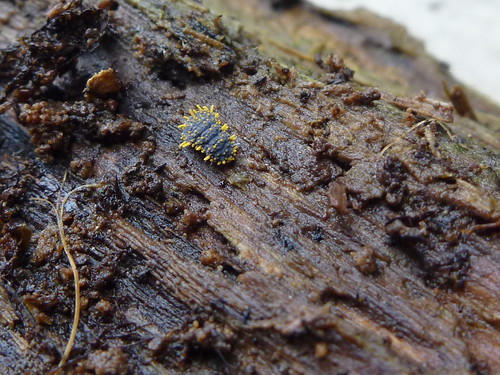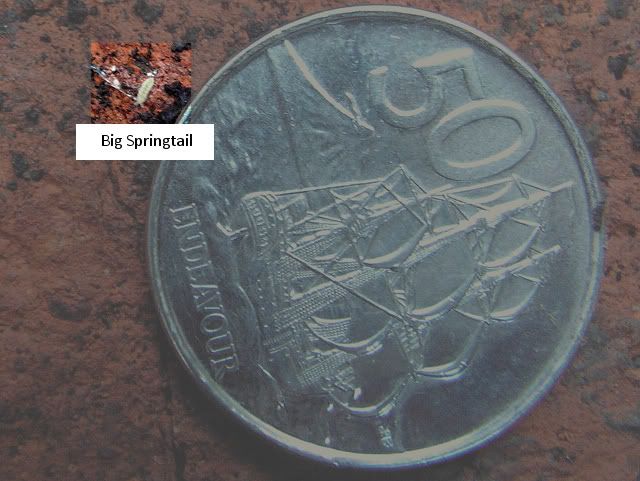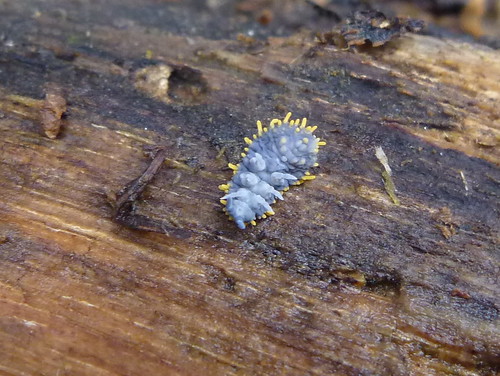Sunday, August 29, 2010
Sunday Spinelessness - New Zealand's GIANT Sprintgtails
I know, a couple of week it was multiple exclamation points, then a reference to lyrics from a band anyone who is remotely cool is trying to forget they ever liked and this week it's all caps all the way. Hopefully, by the end of this post you'll agree that, this time at least, the subject left me with no option.
I missed out a little fact about peripatus when I wrote about them the other day: Dunedin is full of them. There is even a local endemic species which appears to be restricted to one patch of "bush" which is little more than a road-side paddock. So, before I wrote that post I went on a little excursion to another reserve that I know has peripatus in the hope I'd find something to illustrate my ravings. I didn't uncover any of those wonderful animals, but what I did find was every bit as cool:
The little grey-blue thing with the bright yellow spikes is Holacanthella paucispinosa, one of New Zealand's giant springtails. Are you amazed yet? Perhaps you need to know a little more about normal springails before you can appreciate the quiet grandeur of the giants.
I've writen about springtails (also known as Collembola) before, but they're animals that are worth two takes. Springtails are small, six legged arthropods which live mainly in the soil and leaf litter and such moist habitats. This might be the first time you've heard of them, but they've been around you for your whole life. They live on every continent (including Antarctica) and there are as many as 100 000 of them in your average square metre of soil. If you were to go outisde now and pick up a clump of soil from your garden or your lawn you'd almost certainly see a bunch of tiny elongate or globular creatures crawling around and, a few seconds later, vaulting off into the air. That bouncy behavior is achieved with an organ that is neither a spring nor a tail. It's called the furcula (meaning "little fork") an it is held under tension under the abdomen. When a springtail senses danger it can release the furcula, driving it into the ground and flinging the animal away from the threat.
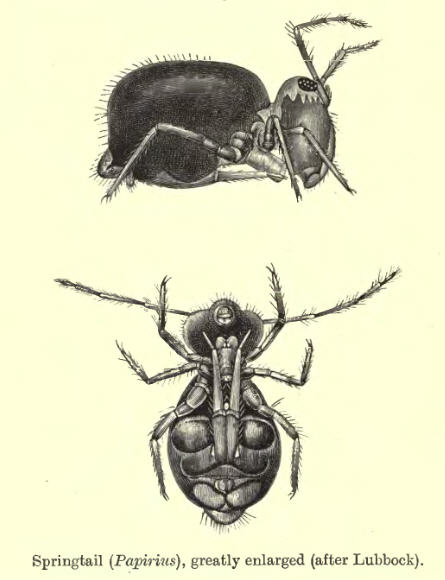
Drawing of a springtail from a British National History Museum display, the furcula is the fork-like organ on the underside of the animal
When they aren't flinging themselves around at random, springtails are playing an important role in the health of the soil. They contribute to the breaking down of organic matter themselves, and, at least as importantly, they move spores from mycorrhizal fungi from plant to plant. Mycorrhza are among the most important organisms on earth. They live on the roots of plants, where they help process soil minerals for their host in exchange for a more or less constant flow of sugars for the plant's photosysthesis. Almost all plant species have Mycorrhzal relationships, and the fungi are key players of the productivity of ecological and agricultural plantations. These two important jobs make springtails a major contributor to nutrient cycling in the soil. Given their enormous abundance and important jobs you might wonder why you don't hear a bit more about springtails. Well, most springtails are really, really small. To prove the point, I've just popped outside and pulled a brick from a retaining wall in our garden (it's OK, the giant clay back stayed up):
The tiny white thing in the upper left is a pretty big springtail (for North American readers, a New Zealand 50 cent coin is almost exactly the same size as a quarter). I didn't think to add something to provide scale in the H. paucispinosa photos, but that springtail would happily cover the "50" on the coin. H. paucispinosa's big cousin from up north, H. duospinosa, would cover a good deal more than half the diameter of the coin.
New Zealand has a fair few giant invertebrates. Every time I introduce myself as someone who studies snails I get asked about the giant carnivorous Powelliphanta (I study small snails that eat plants and are generally considered less cool). Then there's flax snails, weta, the glorious giant bush dragonfly (kapokapowai) and a one and a half metre long long earthworm. The Holacanthella usually get missed off the list of New Zealand giant invertebrates, even though they are many times larger than most of their relatives. I've done my bit in trying to fix that. These are the springtails I mentioned spending a summer looking for in my previous post. I did a summer studentship with Mark Stevens from Allan Wlison Centre in which we collected new samples from all over the country to get a gauge on just where they live and how they are doing. We published some of our results in the New Zealand Journal of Zoology .
As you might have guessed from our paper's venue, we didn't present any earth shattering new results. Instead, we laid the ground for anyone that wanted to do some more detailed studies of these creatures. We looked at all the currently described species in museum collections (Te Papa has pictures of two of the type specimens online) and in our new specimens and found that the existing key, the algorithm by which someone can identify a specimen to a species, didn't quite work. Some of the characters that were meant to diagnose species were found in some individuals of all species So we updated the keys, and presented updated data on the distribution of each species (there were only 18 locality records published when we started). Together, these results might form the basis of further studies.
The distirbution of giant springtail species and populations might be particularly interesting, since they are reliant on rotting hardwood logs for life and don't appear to able to disperse over any great distance. This lack of dispersal ability might mean that genetic relationships between Holacanthella populations might bare the mark of ancient geological and climatic events which have been overwritten in more dispersive animals. The Holacanthella's Australian cousin, the Acanthanura (which it's my patriotic duty to point our aren't quite as big as our giants.) have been used to infer small patches of forest that survived the last ice age. Their reliance on hardwood also makes the New Zealand's giant springtails interesting from a conservation point of view. We spent a lot of the summer in Wellington's hills looking for H. spinosa which was recorded all around the city at the turn of the 20th century. Most of those forests have been logged, and, though there is plenty of regenerating native bush around Wellington, H. spinosa didn't seem to survive the logging. By contrast, managed forests around Nelson and the Tongariro National Park had species-rich and dense population. It seems the giant springtails are particularly susceptible to changes in their forests. In fact, we even suggested that the presence of giant sprintails in a forest patch can be used as a marker for forest health ("canaries in the undergrowth"), in which case the City Council should be pleased to learn they are living in the little forest fragment I found these guys in!
Too big to flail: Giant springtails are too massive to fling themselves about, so they've lost their furcula
I'm sure there are people think that our little paper on these creatures forms part of the "avalanche of low quality research" that is ruining everything for everyone. But, I can't tell you how many fascinating talks I heard at the Evolution meetings about the apple maggot fly, the three spined stickleback and the wild monkey flower. None of those creatures are any more likely an imoprtant model for evolutoinary biology than there names suggest, the only reason it became apparent that they represent important natural experiments is because people did the ground work, worked out a little about these species and published it in a small journal. There will probably never be a Nature paper out New Zealand's GIANT springtails, but you can't know that before you do the research!
Oh, I guess I should answer the most common question I get about these guys: I have no idea why they are covered in spikes.
Steens, M., Winter, D., Morris, R., McCartney, J., & Greenslade, P. (2007). New Zealand's giant Collembola: New information on distribution and morphology for Holacanthella Borner, 1906 (Neanuridae: Uchidanurinae) New Zealand Journal of Zoology, 34 (1), 63-78 DOI: 10.1080/03014220709510065
Labels: collembola, environment and ecology, Holacanthella, my research, photos, research blogging, sci-blogs, sunday spinelessness
Tuesday, August 24, 2010
Sensitivity, specificity and predictive power
There was quite a buzz last week about a study showing a 15 minute brain scan could diagnose autism with "an accuracy rate of 90%" (1,2,3,4 ...). Almost every news outlet that ran with the story seemed to think this new test would pave the way for a quick and efficient screening program for autism. But, as Carl Heneghan at the Guardian pointed out, the ability of a test to correctly diagnose someone with a condition is only one factor that contributes to how useful a test will be. The maths underlying the difference between the accuracy of a test and it's predictive power is famously difficult to grasp, so I thought pretty pictures might do the trick.
50% of the participants of the study that spawned all the fuss had autism, the rest did not. The 90% figure that made the headlines is ability of the brain scan to corroborate the autism diagnosis among the 50% of participants already diagnosed with autism. In other words, the test has a 10% false negative rate. The ability of a test to correctly assign someone with a condition to that condition is called the sensitivity. All of the headlines, and most of the stories, that reported the story failed to mention that the test is worse at picking non-autistic brains from scans. It has an 80% chance of correctly identifying someone as non-autistic (a 20% false positive rate), we call that measure the specificity . So, what do those two rates mean when we run the tests on the study participants? If there were 50 autists and 50 non-autitsts you end up with results like this:

Now, imagine you were in this study population, you didn't know if you were autistic or not, and you got a positive result. How sure could you be that you actually had autism? You might think the answer was 90%, afterall the test is 90% accurate right? In fact, you have to consider the possibility you are one of the ten people we expect to get a false positive result. The probability of having autism if you have a positive test is actually the number of true postives divided by the total number of positives:

So, the test is pretty good but once you include the chance that you have a false-positive the predictive power of the test goes to about 82% . It get's much worse. In the example above we started with autism rate of 50%, in the real world it's something closer to 1%. Let's presume that we aren't going to start a massive screening program for autism, and instead say that 10% of the people referred to doctors for perceived problems in social and educational development actually have autism. How would out test work on that patient population?
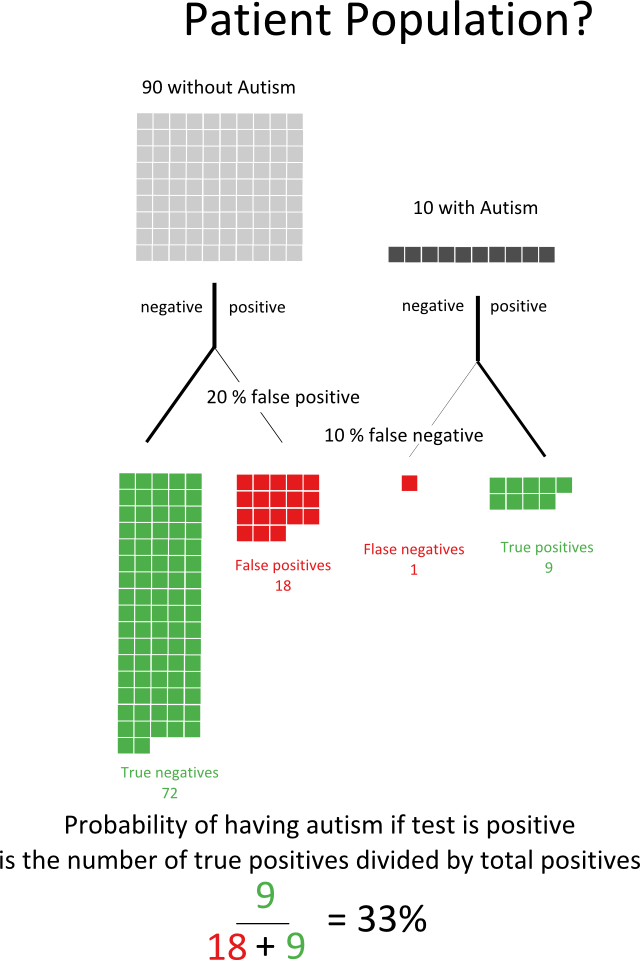
Now if you got a positive result you could still say you probably don't have autism! The predictive power of the test has fallen to 33%. It get's even worse when you think of actually screening the whole population - if 1% of people tested for autism actually had autism then the predictive power of this test would fall to 4.5%.
This problem isn't limited to the new autism scan - any test for a disease which is rare will need to have a very high sensitivity and especially specificity for it to be useful. You sometimes hear people complain that the like of a prostrate cancer screening program using the Prostate Specific Antigen (PSA) test is part of the medical professions attempt to alienate men. In fact, the PSA test has a low specificity. If you were to screen all men for PSA you would get a lot of false positive results, which would lead to a lot of unnecessary biopsies. That's not just an expensive problem, any medical intervention carries a risk so those biopsies would be placing large numbers of men at risk for no good reason. That's not to say the PSA test doesn't have it's uses, if instead of screening all men you only test those who already have a higher risk of prostate cancer you will descrease the number of false positives and the test's predictive power will increase.
Labels: pretty data, sci-blogs, science, science communication, statistics
Wednesday, August 18, 2010
Sunday Spinelessness - The Pollinators of Vancouver 1
Not much time to write today, so let's make the photos do the work! I was really taken by these signs during my recent visit to Vancouver:
That one is form Stanley Park, but there were others around the city and each of them was in-front of a little roosting box made for the the native mason bees. As you can read on the sign, or at the organising group's website, the boxes are part of a project including schools and the community in maintaining these important pollinators. I didn't get any photos of the Blue Orchard Mason Bee these boxes are designed for, but am probably the only preson to have left the University of Bristish Columbia's expansive Botanic Gardens with ten times as many photos of insects and plants. Here is another of Vancouver's native pollinating bees, I'm pretty sure it's Bombus bifarius (it's definitely a bumblebee)
Labels: bee, bumblebee, Canada, environment and ecology, photos, sci-blogs, sunday spinelessness
Just trying to put the punk back into punctured lung
I'm going to be spending the rest of my week keeping up with my real work. Neither science nor the internet have chosen to rest while I catch up with that, so there are lots of interesting things happening that you should be reading about.
***
First, there's the news that from the New Zealand Medical Journal that a woman developed a pneumothorax (air on the lung) following an acupuncture treatment. As Darcy says in the linked article, the best scientific evidence says that acupuncture performed by people who think they are redirecting the flow of ineffable forces with their needles is no more effective than someone prodding people with sharp things where the eff ever they want. There might be a small benefit to having acupuncture, but it's a placebo effect. At the same time, and the present study notwithstanding, the risks associated with acupuncture are relatively small. Which all raises an interesting ethical question: should doctors send their patients to acupuncturists. Obviously treatments that have been shown to work better than a placebo should be the first tack, but if they fail is it OK to knowingly make use of the placebo effect? I don't think it's as simple as it might seem, after all acupuncture can cost a lot of money. Just as it must be a breach of trust for pharmacists to sell small vials of water to patients and call them "homeopathic remedies", surely it's wrong for acupuncturists to take money from patients to pay for their specialist skills in a bogus medical system? Perhaps some of the placebo effect would be down to the idea that the practitioner is steeped in some mystic art, put even if a quick in-clinic sham acupuncture session wouldn't to the trick other placebos treatments might, without incurring the risks associated with acupuncture (no matter how small they might be). Whatever you think, you should leave a comment on Darcy's post because he's just become a father! (It seems his place in life has finally caught up with his sense of humour)
***
There's lots of Science (yay) and Technology (meh) on the TV this week. Media7 is having a special episode on communicating science with a panel featuring Peter Griffin and Rebecca McLeod from the scibog crew. They had a show on a similar theme last year, so it will be interesting to see if anything has changed since. Our local climate cranks certainly haven't become sensible in the interim, but the media does seem to give them a little less room to be stupid so that's something .TVNZ7 also has the first episode of their new sci-tech show Ever Wondered? online. I have to admit that I haven't actually got around to seeing that yet so I can't offer much more than the fact that its there.
***
Last week I had my first crack at teaching a lab. I've done plenty of demonstrating before, which I've always enjoyed (even the lab that's mainly about ripping the heads off Drosophila larvae) but being in charge of the whole show it something else entirely. In the end I had fun, and I think the students went away happy but I have to say I wasn't prepared for the terrifying sea of blank or anguished expression that stared at me when I turned round from explaining something too quickly. So, I asked an award winning lecturer and her crew what they'd do if they faced that terrible sight, you can read the answer here.
***
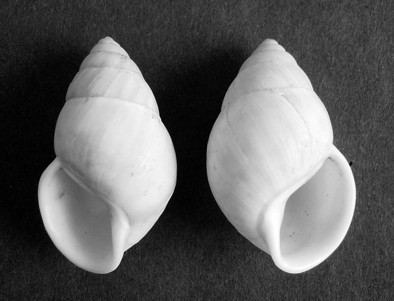
Did you know that snails can be right- or left-handed? In most individuals of most species the shell coils in a "right handed spiral" so when a the shell is placed "apex up" the opening (the aperture) is on the on the right hand side (like the shell on the right above). In a very few snail species most individuals are left-handed. In both left- and right-handed species you get a very few individuals which coil the other way but that pattern usually doesn't persist for any length of time because right- and left-handed shells tend to get in each other's way during mating. It's even been suggested that the reproductive isolation caused by right- and left-handed snails might be enough to help with the generation of new species (I don't know if anyone has ever looked at the distribution of chilarity among closely related snail species, but it might be interesting). Now, Kevin Zelnio has the story of a landsnail species that maintains an even number of right- and left-handed individuals, and just how it manages that.
***
I've been reading In Pursuit of the Gene by James Schwartz which is a really well written history of the discovery of genetics. It's reinforced my notion that statistics was entirely invented by evolutionary biologists; Galton, Pearson (of the correlation coefficient) and Fisher were all trying to understand evolution in developing their methods. I also like the strange coincidence that Hugo de Vries developed what turned out to be a poor theory of evolution based on a misunderstanding of heredity from his observations in the evening primrose. Evening primrose's scientific name is Oenothera lamarckiana, a name which honours French biologist Jean-Baptiste Lemark who has gone down in history as someone whose mistaken ideas on heredity lead him to present a flawed theory of evolution.
***
And finally, a couple of posts from here have featured in blog carnivals lately. So, go tuck in to something spineless at the Birders Lounge or read about the history of science's frauds failures and fools.
Labels: blog blogging, history of science, links, sci-blogs, skepticism
Sunday, August 15, 2010
Sunday Spinelessness - Peripatus!!!
I really like Te Ara, the online New Zealand encyclopedia. I can't begin to tell you how many of my posts here have been made better by the information and the illustrations at that website. Two events last week have made me like Te Ara even more. First, it now includes an article written by my Dad; and second the folks behind Te Ara's twitter account replaced their profile picture with a peripatus (Onychophoran). Peripatus might just be the most wonderful animals that there are - nocturnal predators that crawl through leaf litter killing their prey after immobilising them with glue shot from their heads while still managing to look cute. They've also been the subject of some woolly evolutionary thinking, and New Zealand's peripatus are the centre of one of country's most interesting evolutionary debates. So, in honour of Te Ara's fine taste in profile pictures, today's post is all about our peripatus
 Peripatoides sp. image is CC 2.0 from Flickr user Bruno C. Vellutni
Peripatoides sp. image is CC 2.0 from Flickr user Bruno C. Vellutni
I should probably start with the name. So called "walking worms" or "velvet worms" like the Perpatoides above all belong to the phylum Onychophora (the name refers to the claws on the end of each of those legs). In New Zealand we invariably call our species"peripatus" despite the fact that none of them have ever been considered to be part of the tropical genus Peripatus. I can't quite work out how the name peripatus took hold in the public understanding of these creatures, but it hardly matters as long as we all know what we're talking about. In fact, using peripatus as a common name in English makes for a nice congruence, since that name comes from Latin meaning "to walk about" and the Maori name for these creatures, ngaokeoke derives from the verb "to crawl". And it's fun to say (Stephen Jay Gould claimed he'd never written about onychophorans without mentioning how much he liked to hear the word peripatus).
As I mentioned above, peripatus spend their lives in leaf litter and rotting logs. A couple of years ago I spent a fair amount of my summer walking through forests pulling apart rotting logs looking for certain species of springtails. The springtails we were looking for were few and far between, so you did a lot more searching than finding, but looking through rotting logs always throws up interesting creatures. I couldn't count the number of spiders, bizarre harvestmen, smart little native cockroaches, beetles, centipedes, millipedes and snails I found. But I remember each of the three times I encountered a peripatus. There is something very special about running into one of these creatures in their natural habitat, as they crawl away on legs almost identical to the ones that supported their (marine) ancestors 500 million years ago. But peripatus are more than "living fossils" (actually, nothing's a living fossil, every creature on earth has been evolving for 3.8 billion years) almost everything about these animals is amazing.Their fleshy little legs work without a skeleton (inside our out) because their body is inflated with an incompressible liquid that muscles can work against, they shoot glue across (relatively) large distances to immobilse their prey, they have pretty complex brains and (among Australian species at least) complex social behaviours and for all their lack of morphological diversity they have a great variety of reproductive strategies. Most species are ovoviviparous, which means the young develop in eggs which are retained in the female where they hatch a little while before they are born. A few New Zealand an Australian species lay eggs which are supplied with yolk and left alone and others have gone in the other direction and taken eggs out the equation by giving birth to live young nourished by a placenta. All that and they remain, in the words of PsiWavefront "[really quite] adorable"
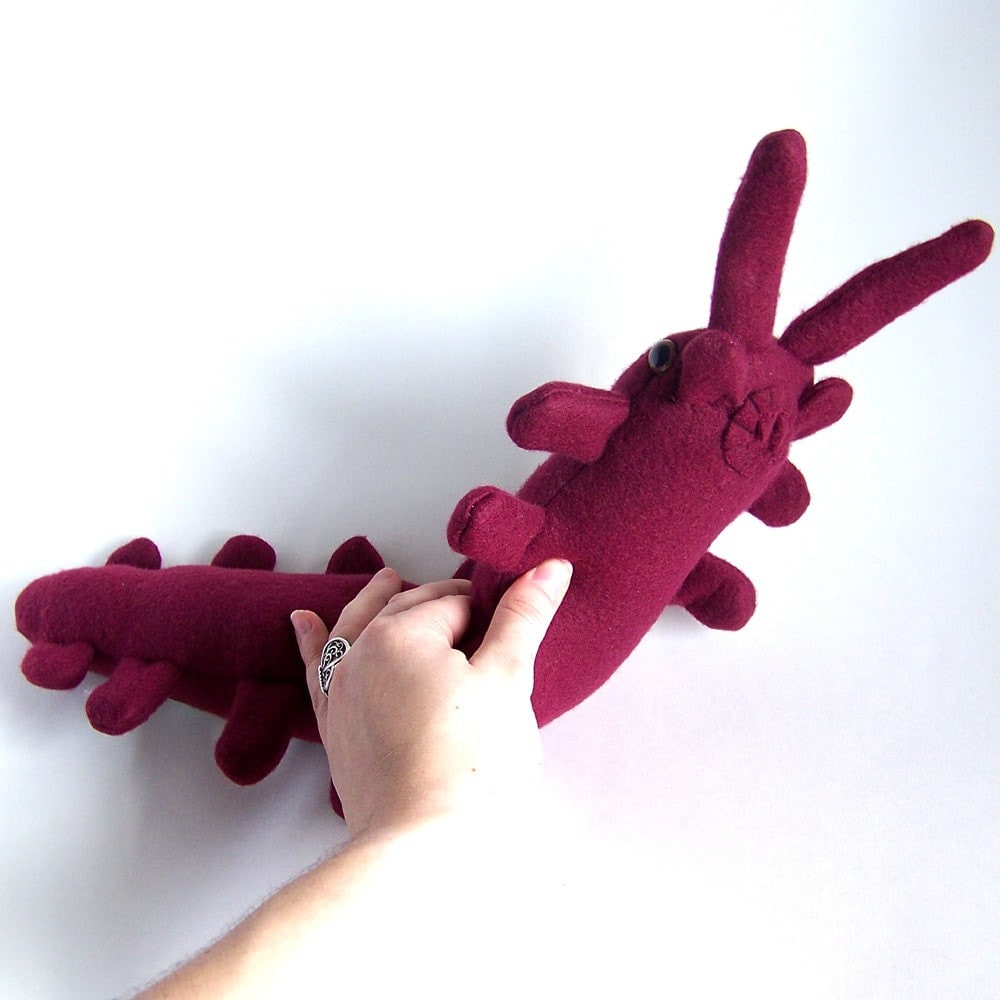
A plush peripatus from Weird Bug Lady's amazing Etsy shop
Peripatus have also fueled some slightly wonky evolutionary thinking, including perhaps the single stupidest idea to be published in a scientific journal - that insects like butterflies and wasps and beetles which have caterpillar-like larvae are the result of ancient hybridisation between caterpillar-like onychophorans and some flying insect. I don't think that idea is likely to become widespread but it's almost impossible to read about peripatus without coming across the idea that they form a "missing link" between the arthropods (animals with jointed limbs and exoskeletons like spiders, insects and crustaceans) and the annelids (earthworms, leeches and their relatives). There is probably no term that annoys me more than "missing link" - its continued use betrays the way we've failed to include what we know about evolution in the way we think about biology. By now we should know that links belong in chains and species belong in trees. More specifically, the term missing link comes from a theological idea called the Great Chain of Being or Scala Naturae which was meant to relate all of Creation in a giant hierarchy from God, who set it all in place, on down to mud with angels, kings, men, women (occasionally in that order) animals and plants filling the gaps. When natural historians brought up in the age of the Great Chain turned their eyes on the biological world they looked for creatures that could fill up the spaces, smoothly linking the "high" and the "low" animals. In that light you might see the stumpy little legs of onychophorans as filling the space between annelids (with segments but never true legs) and arthropods (with segments and specialised limbs associated with particular segments). Something like this:

But ever since Darwin we've known that animals weren't created to fill a spot in a hierarchy. Rather, they've arisen in a branching pattern, with new lineages forming from the repeated splitting of older ones. Modern species aren't links in an evolutionary chain, they are tips in an evolutionary tree. In this way evolution is actually a process that creates gaps - once a lineage splits each of the daughter lineages are free to evolve away from each. If anything the mixture of "worm-like" and "arthropod-like" character in peripatus might be evidence for shared ancestory between these groups (ie, all these groups descend from a segmented ancestor not shared by the un-segmented animals like molluscs) which would help us to understand the order in which those character evolved:
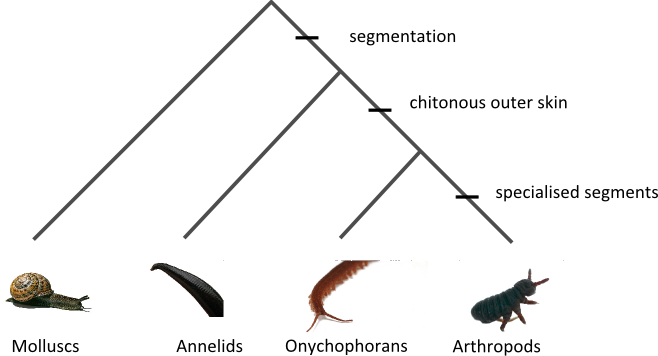
In the tree above the Onychophorans aren't a link between arthropods and annelids, they are their own group with some degree of shared ancestory with each other group. As it happens, when you look at more characters (especially the nervous system, embryonic development and DNA) the apparent relationship between annelids and peripatus breaks down. The "worm-like" properties of the onychophorans are likely down to each group independently arriving at the same solution to problems arising from life as a tubular invertebrate or the maintenance of traits found in the ancestor of all animals and since modified in most lineages but not these ones. Here's how we'd relate the four groups we've been looking at above given what we know today ("spiral cleavage" is a pattern of embryonic development shared by most lophotrochozoan animals):
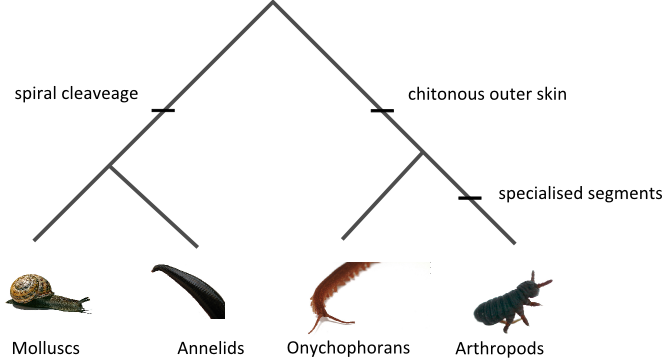
On top of being a biological marvels, New Zealand's peripatus might be able to tell us about our county's geology. In fact, our peripatus might just be the only animals keeping New Zealand above water during the Oligicene. New Zealand got its geological start about 85 million years ago when the land that makes up our mini-continent split away from the super-continent Gondwana and for a long time it was considered likely that most of flora and fauna were on board when the split happened. That geological event and it's biological ramifications have become something of a creation myth for New Zealanders, it suits our image as a a rugged and unique country forging its own way through the world. It just happens to be wrong. Or at least, it's become increasingly clear that most of our flora and fauna are relatively recent arrivals (having been blown or rafted to our litltle islands) and some geologists have suggested the whole of New Zealand may have been underwater in the "Oligicence drowning" about 23 million years ago, an event that would have extinguished any Gondwanan refugees. Our peripatus form part of the debate because their relatives are found in Australia, South America and Africa - all formerly part of Gondwana - and as such provide us with the means to test the idea that our peripatus have been in New Zealand since New Zealand existed. Earlier this year Julia Allwood and colleagues presented a molecular clock study focusing on New Zealand and Australian onychophoran species. The molecular clock doesn't tick as smoothly as a wristwatch, so good dating studies like Allwood et al's almost always include large error bars. Nevertheless, they found that the oldest split between Australian and New Zealand genera was between 24.5 and 136.7 million years, with a point estimate just under 80 million years. It's not quite and open and shut case, but it's probably enough to make our peripatus the best candidate for a Gondwanan relict in New Zealand.
The trees and the chain use the following images: Snail from Hadi Fooladi, Leech from PhatController, Onychophoran from Ant Boy and springtail from Cornell Mushroom Blog. All are licensed under Creative Commons 2.0 license (as is everything here that isn't credited to someone else)
Allwood and colleagues' paper is
Allwood, J., Gleeson, D., Mayer, G., Daniels, S., Beggs, J., & Buckley, T. (2010). Support for vicariant origins of the New Zealand Onychophora Journal of Biogeography, 37 (4), 669-681 DOI: 10.1111/j.1365-2699.2009.02233.x
Labels: evolution, onychophoran, perpipatus, sci-blogs, sunday spinelessness
Sunday, August 8, 2010
Sunday Spinelessness - In the news
Spineless creatures have been all over the news this week. We've had strange beasts appearing on beaches, wondrous finds from the deeps and (apparently) a new front on the war on cancer.
Let's start here in New Zealand with a surprising find on a Wellington beach.
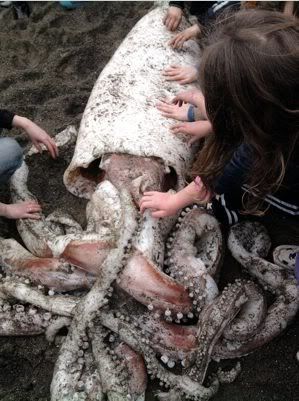
Photo from stuff article /Emma Best
That's a giant squid (Architeuthis sp.) and at 3m long it's a baby, full grown females can reach 13m. Giant squids are really deep sea predators, so beachings are relatively rare. This one appears to have been in a fight. We don't know too much about the food webs at the bottom of the ocean, sperm whales are the only creatures known to take on adult giant squids but sharks and other whales might very well attack sub adults like this one. As an aside, studying parasites might be the best way to work out who eats who in the deeps. When you dissect a shark or a whale its stomach contents give you a picture of what it's eaten recently, when you look at its parasites you can paint a picture of what it's eaten over its lifetime. However the squid got its injuries, they proved fatal. it washed up dead and was returned to the ocean with the next high tide.
Then there was the announcement of the results of the Census of Marine Life, an inventory of the species living in the earth's oceans. The news of that story was almost universally illustrated with pretty pictures of weird animals photographed from deep sea submersibles. Here's a particularly striking example of the genre, an amphipod with a house which showed up in the Guardian and National Geographic:
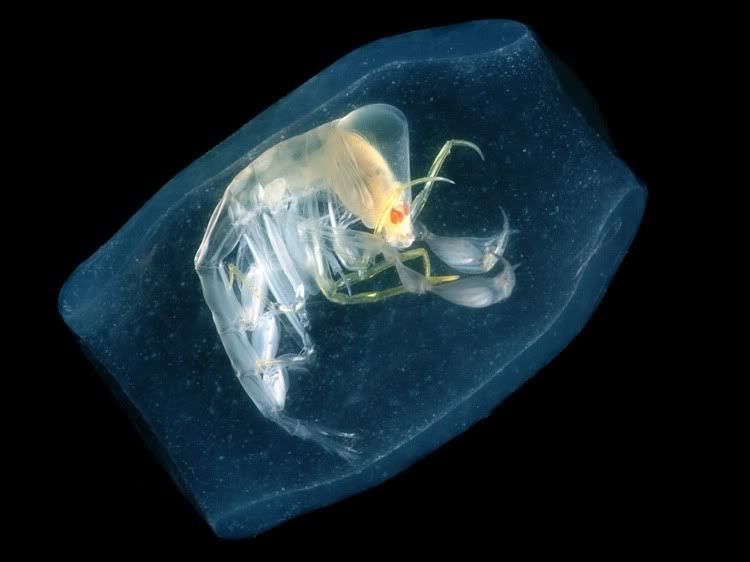
Photo from Texas A&M press
Obviously, that mean-looking shrimp-like amphipod is a spineles creature, but it might suprise you that its transluscent home is also an animal. In fact, it's one of your closest relatives in the biological world. It's a salp, a relative of the sea squirts, and it's a member of the chordata - the same phylum as the all the vertebrates. Matt Cobb has all the details in his guest post at why Evolution is True.
Finally, scientists published the first complete genome sequence from a sponge. As has become customary for genome studies, the press releases and the resulting new stories all suggest that these DNA sequences will help us fight cancer. Well, perhaps. Cancer is ultimately about uncontrolled cell proliferation and sponges are the simplest animals to have to find a way of marshalling thousands of cells into a single body. But is that really the only reason we should be exciting about a tool that helps us to understand the origins of multicellularity, or being able to see where the precursors of the development programs that pattern the bodies of more complex animals came from? I'd like to think the average reader is just an excited by a little scientific awe as they are by some ill defined and far off medical benefit. (Before I sound too grumpy I should say that the press release from UC Santa Barbara was really very good, it's just a shame some of those points didn't get picked up in the reporting.)
To those three stories you can add a call for insects to replace red meat, sub zero octopus venom and a BBC tour of invertebrate collections form the Gulf of Mexico. It really was quite the week for invertebrate news.
Labels: carnivorous sponge, crustacean, genomics, molluscs, porifera, salp, sci-blogs, squid, sunday spinelessness
Sunday, August 1, 2010
Sunday Spineless - Looking into jellyfish eyes
Eyes evolved once. That's the headline conclusion from a recent study of the genetic basis of the development of eyes in jellyfish. If you want the details the ever-awesome Ed Yong has them, so I'll just offer a précis here.
Building an eye is a complex business. Developmental biologists have uncovered a whole series of interacting networks of genes that work in concert to turn a piece of neural tube into your peepers. In just about all bilaterians (that is, animals other than cindarians, ctenophores and sponges) the whole process has one master switch - a gene called PAX6. The pax genes are a family of transcription factors(genes that drive the expression of other genes) that act to define regions on the animal body during early devlopment. The eye-establishing function of PAX6 is so strongly conserved that you express the mouse version of this gene in a Drosophila larvae and set off the eye-building networka(leading to the development of ectopic eyes). In the recent paper researchers went looking for PAX genes in one of the deeper branches of the animal tree, the Cnidaria (comprising corals, anemones and a diverse collection of creatures we usually call jellyfish).
On my recent visit to Vancouver I made it to that city's impressive aquarium (tourist tip: go early or line up for a long time). They have sea otters and dolphins and beluga whales but, true to form, I was most taken by the jellies:
Above you have sea nettles (Chrysaorasp sp.) and below the moon jelly (Aurelia aurita) and my photos hardly do them justice. They were just stunning. My photos also fail to record and important detail, jellies and other cnidarians have eyes. Or at least tiny "eye spots" which are capable of detecting light, if not casting a focused picture of the outside. So,with the sequence of another cnidarian's genome (the starlet sea anenome, Nemaostella vectiniss) as a starting point researchers went looking for PAX genes in the development of that eye spot. They found them in the familiar role, the master switch, but interestingly it's not the PAX genes most closely related to PAX6 that are doing the work. In two different lineages of jellies, the Hydrozoa and the Cubazoa (neither represented above I'm afraid) two different PAX genes are setting the eye making machinery to work. The authors conclude that eye development was originally controlled by suite of PAX genes acting together with a degree of redundancy with each lineage - the Hydrozoa, the Cubazoa and the bilaterians - subsequently losing that redundancy and leaving just one of the PAX genes to act as the master switch. Sounds reasonable to me (but check out a criticism of the idea in comments to Ed Yong's post) but the diagram they use to illustrate that idea is awful :
 Who could imagine animals as wonderful as the cnidarian photographed above, or the sponges I wrote about here or Drosophila were side branches from evolution's mainstream. Yuck. Anyway, I fixed it:
Who could imagine animals as wonderful as the cnidarian photographed above, or the sponges I wrote about here or Drosophila were side branches from evolution's mainstream. Yuck. Anyway, I fixed it:
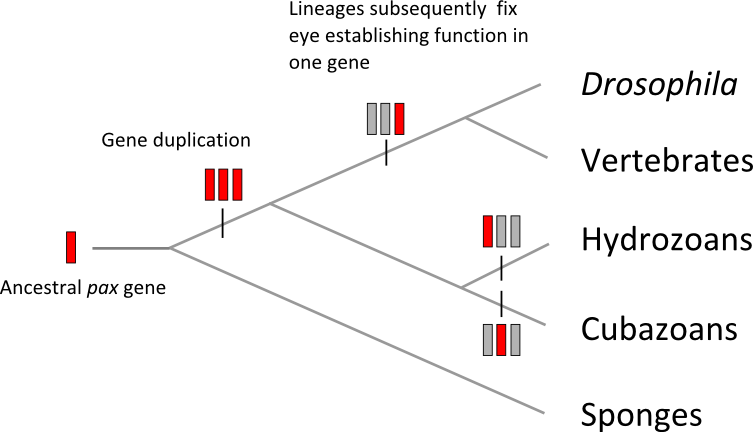
Labels: cindaria, developmental biology, sci-blogs, sunday spinelessness, Vancouver

